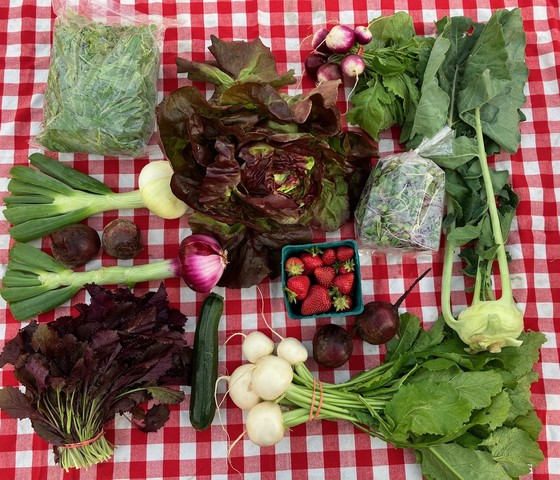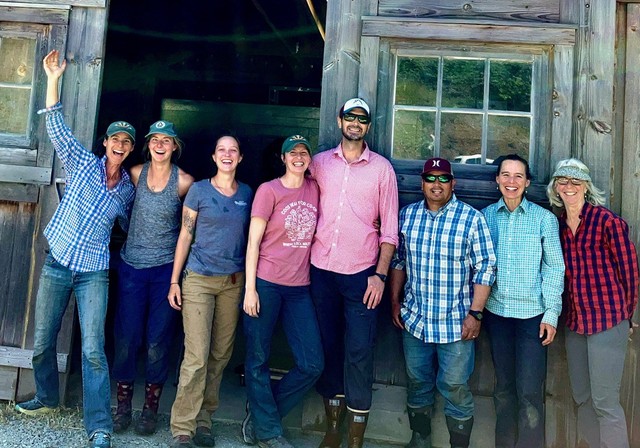- Red Beets
- Baby Bulk Mizuna
- Bunched Mustard Greens
- Hakurei Turnips
- Kohlrabi - purple or green
- Strawberries
- Head Lettuce
- Radish Blend Microgreens
- Purple Radishes
- Red and Yellow Spring Onions
On Rotation:
- Zucchini
- Artichokes
New to your Kitchen this Week:
Mizuna: a mild, yummy Asian green from the mustard family (light green leaves with serrated shape, in the larger bag this week). It's a staple ingredient in Abby's Greens salad, and it can be eaten on it's own to make a mizuna-forward salad (make it as simple or as fancy as you like: sliced radishes, nuts, cheeses, or just a simple vinaigrette). The magic of mizuna is that it also holds up to heat really well, so you can also saute, steam, or stir-fry it, or add it to soup, risotto or pasta. There are lots of inspired recipes on the internet if you google "mizuna" - have a gander and decide for yourself if you want to go in the Asian-inspired direction, or lean Italian, or something else altogether.
Mustard Greens: Some of you will be receiving a dark purple mustard variety; others a blended bunch that contains a handful of varieties. I love mustards greens cooked with a savory, umami flavors like miso. Here are a couple riffs on that idea, Braised Mustard Greens 2 Ways. You can also use the hakurei turnip tops like mustards - throw them into the recipe!
Kohlrabi: In my humble opinion, the best way to eat kohlrabi is raw: peeled, cut into straws, with a little sprinkle of salt. It reminds me of eating sliced jícama with chile and lime in Mexico. Kohlrabi has a tough outer skin that isn't very palatable, so you'll want to peel it with a paring knife or veggie peeler. The tops can be used just like kale or collards, so don't toss them if you're hankering for bonus greens this week. The kohlrabi bulb will store for weeks in the fridge if you cut the leaves off.
How to Keep your Produce Fresh at Home:
We work hard to send you the freshest, highest quality produce we possibly can each week. Some of that relies on harvest strategy and skill, but a big part of it is post-harvest handling. Every fruit and vegetable has a specific temperature and relative humidity it likes for longest storage. You can extend the life of your produce - and reduce waste - if you give your veggies what they want when you get them home. Here's a great guide from the city of Seattle that gives you pointers in a handy chart for every kind of produce there is, from asparagus to zucchini. In the meantime, here are our quick and dirty tips for keeping your produce perky as long as possible:
- Leafy things need to be put in a sealed container or plastic bag. Bagging will help keep the relative humidity high around wilt-prone crops like lettuce, herbs and bunched greens, but it also makes a big difference for root crops like radishes, turnips, carrots, and beets - if you want them to stay firm and crisp.
- Cut the tops off of root crops like radishes, turnips, kohlrabi, and bunched beets and carrots. The roots will store for much longer - and stay crisper - without the transpiring leaves attached. Root crops will keep for weeks - or even months - this way. Potatoes are the lowest maintenance root crop and you can toss them into your crisper without a bag. But bagging won't hurt them and it makes it easier to pull them out of the fridge when it's time to make homefries.
- Some crops, like zucchini and eggplant, like to be stored at 50 degrees with high relative humidity. That's not a set of conditions that most folks have in their kitchen, so the best you can do is put them in your fridge wrapped in a damp towel (or bag them) and use sooner than later. Try to eat them within a week.
- Other crops, like tomatoes and strawberries, will continue to ripen if you leave them on your counter. If you put them in the fridge it will slow ripening significantly. You may want to use refrigeration strategically, say if you're trying to save your berries for a special occasion later in the week. In that case, put them in a lidded tupperware for longest storage. Tomatoes - once we start harvesting those later in the summer - generally don't respond well to refrigeration. It can make them mealy, so best to keep them on your counter or eat them ASAP :)
- Finally, there are a few crops that don't need refrigeration at all: onions, shallots, garlic and winter squash. These things will last the longest in a cool dark place, but your countertop or fruit basket will also work for shorter-term storage.
Introducing our 2023 Farm Crew!
And now, my favorite thing: getting to introduce the wonderful humans behind the scenes at Valley Flora this season!
From left to right: Zoë, Jen, Alexa, Sarah, Allen, Roberto, Abby and Bets
Jen and Alexa are new to our team this year and are both participating in the Rogue Farm Corps Apprenticeship Program. They've been a stellar addition to the crew and have quickly taken on some key responsibilities: deliveries and running the farmstand. We've thrown them into the deep-end with all there is to learn about harvest, packout, irrigation, transplanting, weeding, propagation, greenhouse watering, and much more. On top of all that, they're both learning to drive stick shift amidst the hustle (our farm flatbed is a manual transmission, so it's sink or swim :). Please give them a warm welcome if you see them at your CSA pickup site, or at the farmstand. We are so lucky to have them on the team!
The rest of us are pretty old dogs:
- Allen and Sarah are both in their fourth year with us on the farm, after having worked for 7 years on other farms in Idaho and Hawaii. Sarah manages our propagation greenhouse and all of our microgreens production, as well as helping with key harvests (all that while running her own business as an herbalist, Octopus Herb Garden). Allen is our intrepid and ever-patient crew and harvest leader. He mentors our new crew members on a daily basis as they go about tackling the never-ending to-do lists, and is in charge of production for Octopus Herb Garden (Allen and Sarah culitvate a corner of the farm to supply their apothecary with things like elderberry, St. Johnswort, calendula, echinacea, and much more).
- Roberto has been part of Valley Flora since 2010, before my babies were born! He's a lightning-fast asset to our harvest and packout crew, can transplant like a human piston, and knows pretty much every in and out of our field operations. He's also my right-hand man when it comes to building a new shed, barn or greenhouse, and he handles all the grounds maintenance (mowing & weedeating are a big job, particularly at this time of year). But perhaps most importantly, he's the official Valley Flora Spanish professor - muy divertido para todos! :)
- Abby, my sister, is the one and only Abby of Abby's Greens (world famous!). She's the magician behind that beautiful salad, working unbelievably hard (and mostly solo) to bring you your greens each week. She's also the Valley Flora orchard maven, with a passion for pruning and grafting that is made manifest in our well-tended, extremely diverse orchard.
- Bets, my mom, is the matriarch of it all - the reason we're all here, and a woman who has inspired countless others by the example she has set all her life: that making a lavish living is not as important as living a lifestyle you love. At the age of 71, she's still working the rest of us under the table as she goes about propagating, cultivating and harvesting all the tomatoes, peppers, basil, zucchini and other peak-of-summer crops for our CSA, farmstand, and wholesale accounts.
As for me, Zoë, I love to grow cover crops and butterhead lettuce and sunflowers. I love horses and the high alpine and wild rivers and sweet peppers. I love to write, and I love it when a CSA member tells me they learned to like fennel. (I also, by the way, love my kids, my dog, my family, my husband, and the steaming mug of spicy-gingery homemade chai he hands me on Sunday morning). Not necessarily in that order, just all of it together in one big, happy, messy pile of lucky-to-be-alive-ness.
See you next week!


